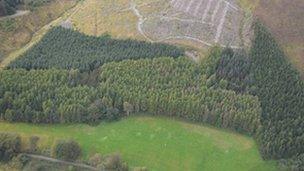Diseased larch felling to have 'huge impact' on Manx landscape
- Published

Aerial surveys by the Forestry Commission in 2011 showed the affected areas
Work to fell hundreds of thousands of infected larch trees in the Isle of Man will begin this week after an "explosion" of a deadly tree disease.
According to the Manx government about 50% of the island's larch population is currently infected by Phytophthora ramorum.
Forester Jason Bolt said the essential work will have a "huge impact on the island's landscape".
The Forestry Division plans to fell 450 hectares (1,111 acres) of larch.
Senior forester John Walmsley said the disease, first detected on the island in 2010, had "exploded" since March.
In July, a survey by the Manx Forestry Directorate showed a "considerable spread" of the disease in the north of the island.
Since then it has spread to the south, east and west.
'Vital step'
Mr Bolt said: "Larch makes up around 20% of our forests and in the short term it will have a major impact."
Environment Minister Phil Gawne said it was a "vital step" for which "quick action was needed".
The increase has been attributed to weather conditions last year which were ideally suited to the spread of the fungus-like pathogen.
Mr Bolt said: "There are roughly 2,000 larch trees per hectare, so it is hundreds of thousands of trees.
"The next few months are very important. We need to get as many trees down as possible before they spawn.
"For that we need experts from the UK to tackle it head on. We will be looking to use local contractors in the future."
According to the Forestry Division the felled timber can still be used as fire wood in the future, if the bark is removed.
The first felling is scheduled to take place in Tholt-y-Will plantation later this week.
Phytophthora ramorum, also known as sudden oak death, was first found on the island in Ballaugh, during a routine aerial inspection.
The fungus-like pathogen causes the ramorum disease which is particularly serious in Japanese larch trees and rhododendrons.
Fifty hectares (123 acres) have already been felled in the Colden and Ballaugh areas.
- Published31 October 2011
- Published8 March 2012
- Published20 October 2011